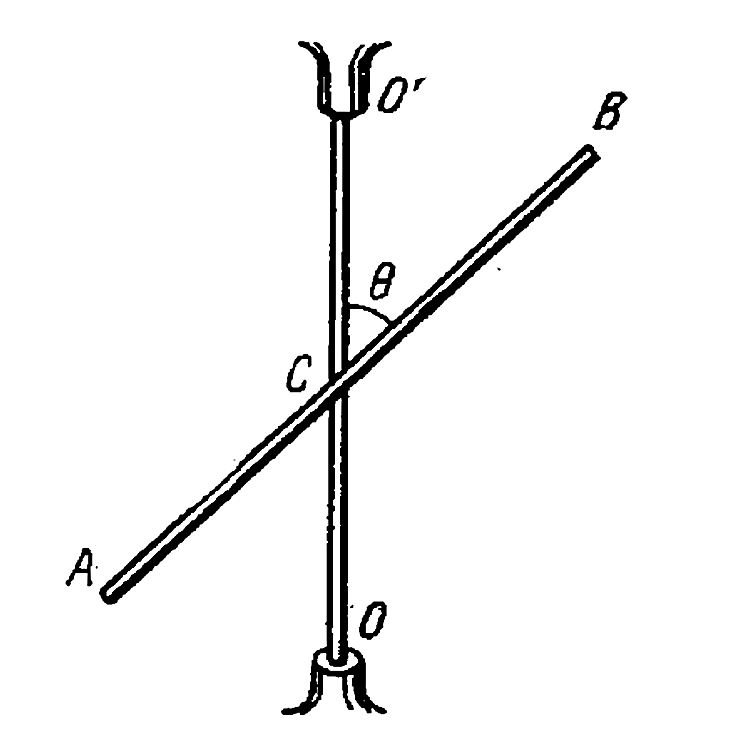Two rods having the same proper length l0 move lengthwise toward each other parallel to a common axis with the same velocity v relative to the laboratory frame of reference. What is the length of each rod in the reference frame fixed to the other rod?
The velocity of one of the rods in the reference frame fixed to the other rod is
V=v+v1+v2c2=2v1+β2
The length of the moving rod in this frame is
l=l0
⎷1−4v2/c2(1+β2)2=l01−β21+β2
Topper's Solved these Questions
- PHYSICAL FUNDAMENTALS OF MECHANICSBOOK - IE IRODOV, LA SENA & SS KROTOVCHAPTER - PHYSICAL FUNDAMENTALS OF MECHANICSEXERCISE - Hydrodynamics
25 Videos
- OSCILLATIONS AND WAVESBOOK - IE IRODOV, LA SENA & SS KROTOVCHAPTER - OSCILLATIONS AND WAVESEXERCISE - Electromagnetic Waves, Radiation
36 Videos
- THERMODYNAMICS AND MOLECULAR PHYSICSBOOK - IE IRODOV, LA SENA & SS KROTOVCHAPTER - THERMODYNAMICS AND MOLECULAR PHYSICSEXERCISE - Transport Phenomena
38 Videos
Similar Questions
Two rods of the same proper length l0 move toward each other parallel to a common horizontal axis. In the reference frame fixed to one of the rods the time interval between the moments, when the right and left ends of the rods coincide, is equal to Δt. What is the velocity of one rod relative to the other?
View SolutionA rod moves lengthwise with a constant velocity v relative to the inertial reference frame K. At what value of v will the length of the rod in this frame be η=0.5% less than its proper length?
View SolutionTwo particles move toward each other with velocities v1=0.50c and v2=0.75c relative to a laboratory frame of reference. Find:
(a) the approach velocity of the particles in the laboratory frame of reference,
(b) their relative velocity.
View SolutionTwo relativistic particles move at right angles to each other in a laboratory frame of reference, one with the velocity v1 and the other with the velocity v2. Find their relative velocity.
View SolutionThe rod A′B′ moves with a constant velocity v relative to the rod AB (figure). Both rods have the same proper length l0 and at the ends of each of them clocks are mounted, which are synchronized pariwise: A with B and A′ with B′. Suppose the moment when the clock B′ gets opposite the clock A is taken for the beginning of the time count in the reference frames fixed to each of the rods. Determine:
(a) the readings of the clocks B and B′ at the moment when they are opposite each other,
(b) the same for the clocks A and A′.

View SolutionFind the proper length of a rod if in the laboratory frame of reference its velocity is v=c/2, the length l=1.00m, and the angle between the rod and its direction of motion is θ=45∘.
View SolutionThe rod AB oriented parallel to the x′ axis of the reference frame K′ moves in this frame with a velocity v′ along its y′ axis. In its turn, the frame K′ moves with a velocity V relative to the frame K as shown in figure. Find the angle θ between the rod and the x axis in the frame K.

View SolutionA rod moves along a ruler with a constant velocity. When the positions of both ends of the rod are marked simultaneously in the reference frame fixed to the rule, the difference of readings on the rule is equal to Δx1=4.0m. But when the positions of the rod's ends are marked simultaneously in the reference frame fixed to the rod, the difference of readings on the same ruler is equal to Δx2=9.0m. Find the proper length of the rod and its velocity relative to the ruler.
View SolutionA rod AB oriented along the x axis of the reference frame K moves in the positive direction of the x axis with a constant velocity v. The point A is the forward end of the rod, and the point B its near end. Find:
(a) the proper length of the rod, if at the moment tA the coorniate of the point A is equal to xA, and at the moment tB the coordinate of the point B is equal to xB,
(b) what time interval should separate the markings of coordinates of the rod's ends in the frame K for the difference of coordinates to become equal to the proper length of the rod.
View SolutionA midpoint of a thin uniform rod AB of mass m and length l is rigidly fixed to a rotation axle OO′ as shown in figure. The rod is set into rotation with a constant angular velocity ω. Find the resultant moment of the centrifugal forces of inertia relative to the point C in the reference frame fixed to the axle OO′ and to the end.

View Solution
